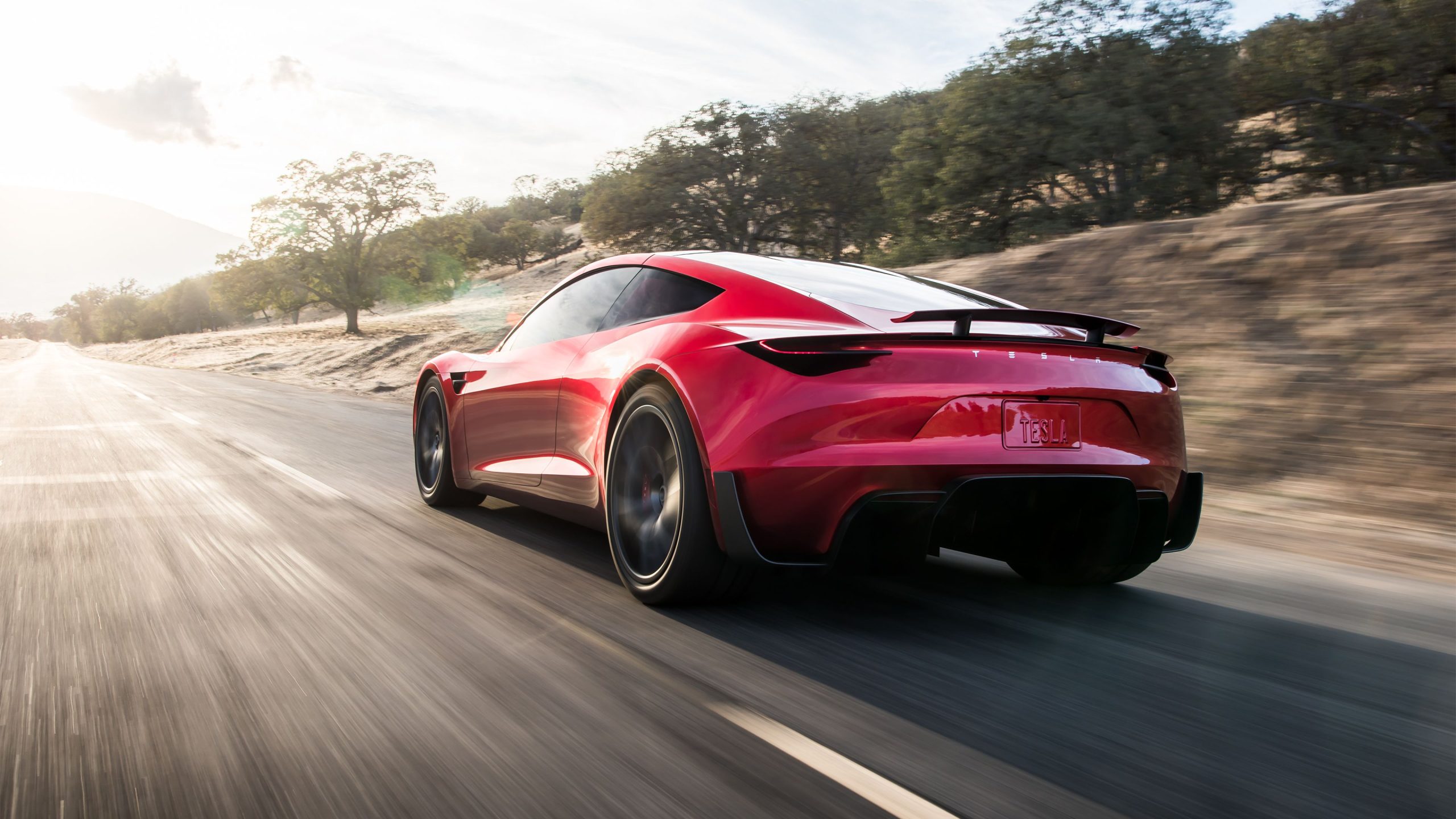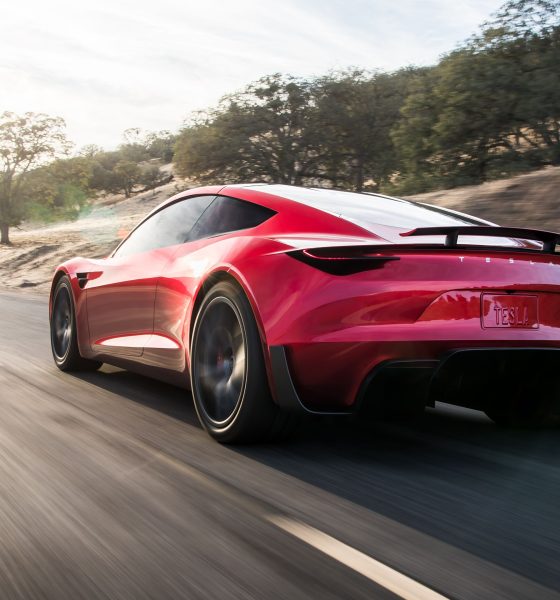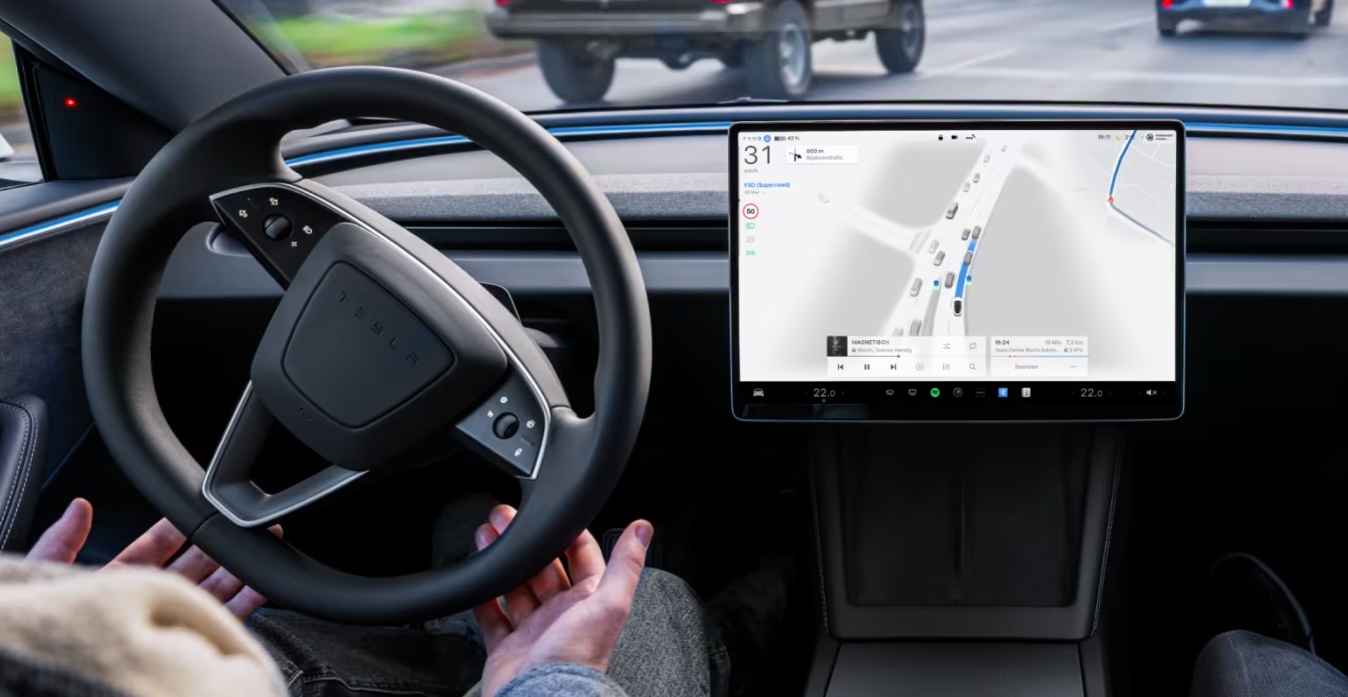

News
Tesla Roadster’s ‘SpaceX package’ with rocket thrusters could actually work
This weekend proved to be a fruitful one for Elon Musk’s Twitter followers and fans of the next-generation Tesla Roadster, as the billionaire entrepreneur discussed, in honest-to-goodness seriousness, how the electric car maker would utilize SpaceX technology to make the upcoming all-electric supercar an absolute monster on wheels. Needless to say, there was quite a lot to take in.
Musk started off his Twitter discussion on the next-generation Roadster by stating that the car will feature ~10 rocket thrusters that are “arranged seamlessly around (the) car.” Musk further noted that the thrusters would “dramatically” improve acceleration, braking, and cornering, to the point that the Roadster would be able to fly — a reaffirmation of his previous statement referring to the vehicle having the capability to fly “short hops.”
Musk noted that Tesla would be using SpaceX’s Composite Overwrapped Pressure Vessel (COPV), a container consisting of a thin, non-structural liner wrapped with a structural fiber composite. COPVs are designed to hold a fluid under pressure, and are used by SpaceX’s first-stage rocket boosters during re-entry and landing. Musk further explained the use of SpaceX’s technology in later tweets.
SpaceX option package for new Tesla Roadster will include ~10 small rocket thrusters arranged seamlessly around car. These rocket engines dramatically improve acceleration, top speed, braking & cornering. Maybe they will even allow a Tesla to fly …
— Elon Musk (@elonmusk) June 9, 2018
While the idea of using rocket propulsion to enhance the performance of an all-electric supercar might seem to be well into the realms of science fiction, using COPVs for the next-gen Roadster is actually pretty feasible, at least from a technical standpoint. SpaceX’s COPVs have operating pressures of around 350 bars (5,000 psi) and too powerful for a land vehicle. If Tesla installs a similar version of SpaceX’s upper stage thrusters that are used in guiding rockets, rear-mounted devices could store just enough compressed air to provide Tesla’s next-gen Roadster an additional boost in acceleration for a short duration.
Note, gas contained would be ultra high pressure air in a SpaceX rocket COPV bottle. The air exiting the thrusters would immediately be replenished whenever vehicle pack power draw allowed operation of the air pump, which is most of the time.
— Elon Musk (@elonmusk) June 10, 2018
Rocket thrusters placed in front of the vehicle that provides thrust opposite of the Roadster’s direction of travel, at least in concept, could help the electric car’s braking capability, while thrusters placed along each side of the vehicle can help in cornering by providing lateral force. In order to accomplish this, however, Tesla would have to carefully balance the weight of components from the upgraded SpaceX package – Musk noted that the vehicle would sacrifice its rear seats from the standard 2+ 2 configuration to accommodate the additional hardware – with output from the rocket thrusters to maximize the vehicle’s performance. Onboard electric air pumps would repressurize the space-grade containers when they were depleted, making for repeat fun, at least in a theoretical sense. Musk also stated that SpaceX COPVs that will be used for the next-generation Roadster will be durable, and be “literally bulletproof.”
Exactly. Total energy stored even in ultra compressed air is low vs battery, but power output is insane. The composite overwrapped pressure vessel (COPV) is most advanced ever made. It’s what SpaceX is qualifying for NASA crewed missions. Extremely robust — literally bulletproof.
— Elon Musk (@elonmusk) June 10, 2018
Overall, Musk reiterated that the next-generation Tesla Roadster is designed to be the best car in the industry when it gets released. During his tweetstorm, Musk mentioned that with the all-electric supercar, Tesla is attempting to beat ICE vehicles on “every performance metric;” thus transferring the “halo crown effect” gas cars have as the top speed standards in the automotive market.
New details about Tesla’s next-generation Roadster have been released by Elon Musk lately. The SpaceX option for the vehicle was announced during the 2018 Annual Shareholder Meeting, and not long after that, Musk also revealed that the vehicle would feature an “Augmented Mode” designed to “enhance human driving ability,” thereby providing assistance to drivers who would be operating the insanely powerful supercar.
During the unveiling of the next-generation Tesla Roadster, Elon Musk noted that the purpose of the all-electric supercar is to give a “hardcore smackdown” to gasoline-powered cars. The specs of the vehicle that were unveiled then, which are representative of the all-electric supercar’s base trim, are already record-breaking, including a 0-60 mph time of 1.9 seconds, a quarter-mile time of 8.9 seconds, a top speed of over 250 mph, 620 miles of range thanks to a 200 kWh battery, and 10,000 Nm of torque. With the Roadster’s SpaceX option, the all-electric supercar could very well establish a new class of vehicles that lie beyond the hypercar echelon.

News
Tesla FSD Supervised ride-alongs in Europe begin in Italy, France, and Germany
The program allows the public to hop in as a non-driving observer to witness FSD navigate urban streets firsthand.

Tesla has kicked off passenger ride-alongs for Full Self-Driving (Supervised) in Italy, France and Germany. The program allows the public to hop in as a non-driving observer to witness FSD navigate urban streets firsthand.
The program, detailed on Tesla’s event pages, arrives ahead of a potential early 2026 Dutch regulatory approval that could unlock a potential EU-wide rollout for FSD.
Hands-Off Demos
Tesla’s ride-along invites participants to “ride along in the passenger seat to experience how it handles real-world traffic & the most stressful parts of daily driving, making the roads safer for all,” as per the company’s announcement on X through its official Tesla Europe & Middle East account.
Sign-ups via localized pages offer free slots through December, with Tesla teams piloting vehicles through city streets, roundabouts and highways.
“Be one of the first to experience Full Self-Driving (Supervised) from the passenger seat. Our team will take you along as a passenger and show you how Full Self-Driving (Supervised) works under real-world road conditions,” Tesla wrote. “Discover how it reacts to live traffic and masters the most stressful parts of driving to make the roads safer for you and others. Come join us to learn how we are moving closer to a fully autonomous future.”
Building trust towards an FSD Unsupervised rollout
Tesla’s FSD (Supervised) ride-alongs could be an effective tool to build trust and get regular car buyers and commuters used to the idea of vehicles driving themselves. By seating riders shotgun, Tesla could provide participants with a front row seat to the bleeding edge of consumer-grade driverless systems.
FSD (Supervised) has already been rolled out to several countries, such as the United States, Canada, Australia, New Zealand, and partially in China. So far, FSD (Supervised) has been received positively by drivers, as it really makes driving tasks and long trips significantly easier and more pleasant.
FSD is a key safety feature as well, which became all too evident when a Tesla driving on FSD was hit by what seemed to be a meteorite in Australia. The vehicle moved safely despite the impact, though the same would likely not be true had the car been driven manually.
News
Swedish union rep pissed that Tesla is working around a postal blockade they started
Tesla Sweden is now using dozens of private residences as a way to obtain license plates for its vehicles.

Two years into their postal blockade, Swedish unions are outraged that Tesla is still able to provide its customers’ vehicles with valid plates through various clever workarounds.
Seko chairman Gabriella Lavecchia called it “embarrassing” that the world’s largest EV maker, owned by CEO Elon Musk, refuses to simply roll over and accept the unions’ demands.
Unions shocked Tesla won’t just roll over and surrender
The postal unions’ blockade began in November 2023 when Seko and IF Metall-linked unions stopped all mail to Tesla sites to force a collective agreement. License plates for Tesla vehicles instantly became the perfect pressure point, as noted in a Dagens Arbete report.
Tesla responded by implementing initiatives to work around the blockades. A recent investigation from Arbetet revealed that Tesla Sweden is now using dozens of private residences, including one employee’s parents’ house in Trångsund and a customer-relations staffer’s home in Vårby, as a way to obtain license plates for its vehicles.
Seko chairman Gabriella Lavecchia is not pleased that Tesla Sweden is working around the unions’ efforts yet again. “It is embarrassing that one of the world’s largest car companies, owned by one of the world’s richest people, has sunk this low,” she told the outlet. “Unfortunately, it is completely frivolous that such a large company conducts business in this way.”
Two years on and plates are still being received
The Swedish Transport Agency has confirmed Tesla is still using several different workarounds to overcome the unions’ blockades.
As noted by DA, Tesla Sweden previously used different addresses to receive its license plates. At one point, the electric vehicle maker used addresses for car care shops. Tesla Sweden reportedly used this strategy in Östermalm in Stockholm, as well as in Norrköping and Gothenburg.
Another strategy that Tesla Sweden reportedly implemented involved replacement plates being ordered by private individuals when vehicles change hands from Tesla to car buyers. There have also been cases where the police have reportedly issued temporary plates to Tesla vehicles.
News
Czech Deputy excited for Tesla FSD, hints at Transport Committee review
The ANO party lawmaker shared his thoughts about FSD in a post on social media platform X.

Martin Kolovratník, a Czech Republic Chamber of Deputies member, has expressed his excitement for Tesla’s Full Self-Driving (FSD) after an apparent constituent called for a quick approval for the advanced safety system.
The ANO party lawmaker, who drives both diesel and EV, shared his thoughts about the matter in a post on social media platform X.
The official’s initial statements
Kolovratník kicked off the exchange with a post outlining his coalition’s efforts to scrap highway toll exemptions for electric vehicles and plug-ins starting in 2027.
“Times have changed. Electric vehicles are no longer a fringe technology, but a full-fledged part of operations. And if someone uses the highway network, they should follow the same rules as everyone else. That’s the basis of fairness,” he wrote.
He emphasized equity over ideology, noting his personal mix of diesel and electric driving. “For this reason, there is no reason to continue favoring one technology at the expense of another… It’s not about ideology, it’s about equal conditions. That’s why we clearly agreed within the new coalition: the exemption for electric vehicles and plug-ins will end in 2027. The decision is predictable, understandable, and economically sound.”
Tesla FSD enthusiasm
The conversation pivoted to Tesla’s FSD when X user @robotinreallife, who seems to be one of the official’s constituents, replied that other matters are more important than ending highway exemptions for EVs.
“I’m happy to pay for the highway, but I have a question about a much more fundamental matter: The Netherlands will approve the operation of Tesla FSD in February 26, a technology that has been proven to reduce accidents. The Czech Republic has the option to immediately recognize this certification. Do you plan to support this step so that we don’t unnecessarily delay?” the X user asked.
Kolovratník responded promptly, sharing his own excitement for the upcoming rollout of FSD. “I know about it. I like it and it seems interesting to me. Once we set up the committees and subcommittees, we’ll open it right away in that transport one. Thanks for the tip, I’ll deliver the report,” the official noted in his reply on X.
Kolovratník’s nod to FSD hints at the system’s potentially smooth rollout to Czechia in the coming year. With the Netherlands possibly greenlighting FSD (Supervised) in early 2026, Kolovratník’s commitment could accelerate cross-border certification, boosting FSD’s foray into Europe by a notable margin.









